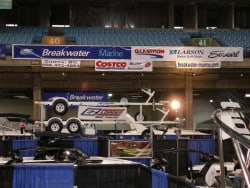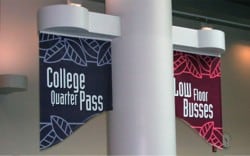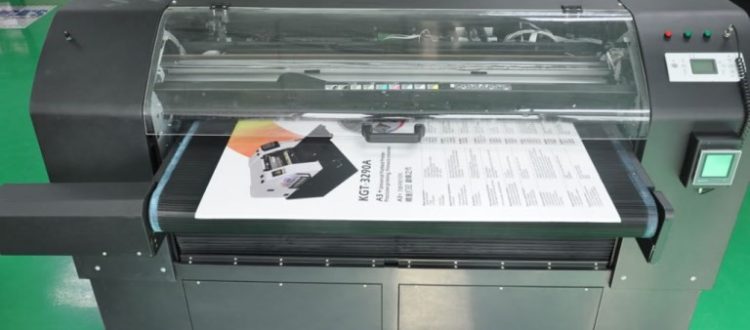Indoor versus outdoor banners. The resolution of the images you are to send for printing. And, the best file types to save your banner designs for printing.
Question: Is there any difference between outdoor and indoor banners?
Generally, a banner that can be used indoors can also be used out of doors. However, there are some differences in construction that should be noted if you know that your banner is going to be used out of doors.
 With an indoor banner, we generally assume that there will be very little wind to affect the banner, so finishing can be done fairly simply, or not at all in the case of fabric banners. With dye sublimation printed cloth banners, the polyester can be hot knife cut to seal the edges so that the threads don’t fray. Then, either grommets along the edges or in the corners or a pole pocket on the top and bottom should be good enough for most indoor environments.
With an indoor banner, we generally assume that there will be very little wind to affect the banner, so finishing can be done fairly simply, or not at all in the case of fabric banners. With dye sublimation printed cloth banners, the polyester can be hot knife cut to seal the edges so that the threads don’t fray. Then, either grommets along the edges or in the corners or a pole pocket on the top and bottom should be good enough for most indoor environments.
Tips When Using Vinyl Banners Indoors
That also holds true for vinyl banners that are used indoors. However, if vinyl banners are going to be used outdoors, it would be good to use some of the following techniques for finishing and reinforcing.
- Web-reinforced hemming: this basically is done by sewing nylon stripping into the hem of the banner. This also reinforces any grommets used around the perimeter of the banner by giving them a more substantial surface to grip.
- Pole pockets with reinforced hemming: In instances where there is a large banner with high wind potential, say, stretched between two street poles across a street, a better way to install this type of banner installation is to run a cable through the top and bottom pole pockets of the banner and stretch it across the street this way.
- If the above banner is in a super high wind area, it might be better yet to use a vinyl mesh banner, and they can be printed as double sided mesh banners as well. The same webbing reinforcement should be used on these banners as well.
For Fabric Banners
Typically, fabric banners are not used outdoors, but that is changing with the improved polyester fabrics and dye sublimation printing that is commonly being done now. Polyester has the added benefit of being washable, although I don’t know anyone who’s actually done it.
Light pole or street pole banners are very often made of fabric, either polyester or acrylic most frequently. Because street pole banners are generally smaller than other types of banners, fabric is a great choice for this usage, and they look great!
Question: I need to have some fabric and vinyl banners printed. What resolution does my designer need to send the images at, and what type of files are best for printing?
I’ll answer the second part of the question first.
Best File Types
The best file types for printing will typically be .eps (encapsulated postscript), .ai (Adobe Illustrator), or a flattened .pdf (portable document file).
 Any of those should work just fine, but the first part of the question is more important, and has a variety of factors that will affect how it prints, including the printing method used. With digital printing, a 3×8 foot banner, for instance, would probably look great at 300 dpi at 100%, but you may not need that high of resolution if the viewing distance is 50 to 100 feet as that would be a very large file if it has a photographic background.
Any of those should work just fine, but the first part of the question is more important, and has a variety of factors that will affect how it prints, including the printing method used. With digital printing, a 3×8 foot banner, for instance, would probably look great at 300 dpi at 100%, but you may not need that high of resolution if the viewing distance is 50 to 100 feet as that would be a very large file if it has a photographic background.
Vector Files
Of course, vector files are the best, but where photo images or other multi-colored graphics are involved, vector images are not yet available for these types of images, although rumor has it that they’re coming. That may revolutionize file transfer sizes. We don’t know yet.
File Resolution for Dye Sublimation of Cloth Banners
If you have a dye sublimation printed cloth banner, however, you should be able to use a lower resolution file. For the same 3×8 foot banner, because of the way the heat and pressure work, as well as the thread weave of the polyester banner fabric, the continuous tone printing of dye sublimation will create a photo-like appearance with even a low dpi file, and it will be a lot smaller to transfer.
File Resolution for Smaller Graphics
If you are doing art prints on smaller sized graphic material, you may want a little higher resolution. However, again, 200 dpi should be fine for dye sub printing, even a fine art print, especially if it’s on a canvas-like material with a lower thread count.
If you are looking to get your designs printed on large format banners, go here: https://www.visigraph.com/fabric-vinyl-cloth-banners/
Popular Posts:




